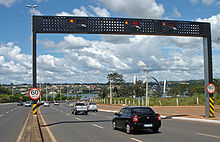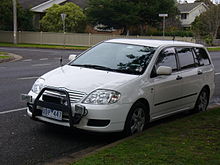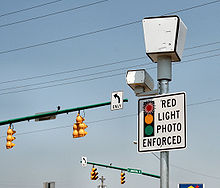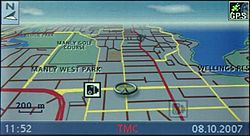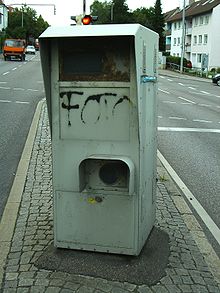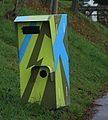- Traffic enforcement camera
-
A traffic enforcement camera (also red light camera, road safety camera, road rule camera, photo radar, photo enforcement, speed camera, Gatso) is an automated ticketing machine. It may include a camera which may be mounted beside or over a road or installed in an enforcement vehicle to detect traffic regulation violations, including speeding, vehicles going through a red traffic light, unauthorized use of a bus lane, for recording vehicles inside a congestion charge area.
The latest automatic number plate recognition systems can be used for the detection of average speeds and raise concerns over loss of privacy and the potential for governments to establish mass surveillance of vehicle movements and therefore by association also the movement of the vehicle's owner. Vehicles owners are often required by law to identify the driver of the vehicle and a case was taken to the European Court of Human Rights who found that the Human Rights Act 1998 was not being breached. Some groups, such as the National Motorists Association in the USA, claim that systems "encourage ... revenue-driven enforcement" rather than the declared objectives.[1]
Contents
Types
Bus lane enforcement
Some bus lane enforcement cameras use a sensor in the road which triggers a number plate recognition camera which compares the vehicle registation plate with a list of approved vehicles and records images of other vehicles.[2] Other systems use a camera mounted on the bus, for example in London where they monitor Red routes[3] on which stopping is not allowed for any purpose (other than taxis and disabled parking permit holders).[4]
On Monday, February 23, 2009, New York City announced testing camera enforcement of bus lanes on 34th Street in Midtown Manhattan where a New York City taxi illegally using the bus lanes would face a fine of $150 adjudicated by the New York City Taxi and Limousine Commission.[5]
Red light enforcement
A red light camera is a traffic camera that takes an image of a vehicle that goes through an intersection where the light is red. The system continuously monitors the traffic signal and the camera is triggered by any vehicle entering the intersection above a preset minimum speed and following a specified time after the signal has turned red.
Speed limit enforcement
Main article: Speed limit enforcementSpeed enforcement cameras are used to monitor compliance with speed limits which may use Doppler, LIDAR or Automatic number plate recognition. Other speed enforcement systems are also used which are not camera based.
Fixed or mobile speed camera systems that measure the time taken by a vehicle to travel between two or more fairly distant sites (from several hundred metres to several hundred kilometres apart) are called automatic number plate recognition (ANPR) cameras. These cameras time vehicles over a known fixed distance, then calculate the vehicle's average speed for the journey. The name derives from the fact that the technology uses infrared cameras linked to a computer to "read" a vehicle's registration number and identify it in real-time.[6]
Stop sign enforcement
In 2007, the Mountains Recreation and Conservation Authority (MRCA), in California, installed the first stop sign cameras in the United States. The five cameras are located in state parks such as Franklin Canyon Park and Temescal Gateway Park. The operator, Redflex Traffic Systems Inc., is paid $20 per ticket. The fine listed on the citation is $100.[7] In 2010 a class action suit was filed against MRCA.[8]
Number plate recognition systems
Automatic number plate recognition can be used for purposes unrelated to enforcement of traffic rules. In principle any agency or person with access to data either from traffic cameras or cameras installed for other purposes can track the movement of vehicles for any purpose.[9]
In Australia's SAFE-T-CAM system, ANPR technology is used to monitor long distance truck drivers to detect avoidance of legally prescribed driver rest periods.[10]
The United Kingdom's police ANPR system logs all the vehicles passing particular points in the national road network, allowing authorities to track the movement of vehicles and individuals across the country.[11][12]
In the UK an 80-year-old pensioner John Catt and his daughter Linda (with no criminal record between them) were stopped by City of London Police while driving in London, UK in 2005, had their vehicle searched under section 44 of the Terrorism Act 2000 and were threatened with arrest if they refused to answer questions. After they complained formally, it was discovered they were stopped when their car was picked up by roadside ANPR CCTV cameras; it had been flagged in the Police National Computer database when they were seen near EDO MBM demonstrations in Brighton. Critics point out that the Catts had been suspected of no crime, however the UK's mass surveillance infrastructure allowed them to be targeted due to their association.[13]
Other
- Congestion charge cameras to detect vehicles inside the chargeable area which have not paid the appropriate fee
- High-occupancy vehicle lane cameras to identify vehicles violating occupancy requirements.[14]
- Level crossing cameras to identifying vehicles crossing railways at grade
- Noise pollution cameras that record evidence of heavy vehicles that break noise regulations by using engine braking
- Parking cameras which issue citations to vehicles which are illegally parked or which were not moved from a street at posted times.[15]
- Toll-booth cameras to identify vehicles proceeding through a toll booth without paying the toll
- Turn cameras at intersections where specific turns are prohibited on red. This type of camera is mostly used in cities or heavy populated areas.
- Automatic number plate recognition systems can be used for multiple purposes, including identifying untaxed and uninsured vehicles, stolen cars and potentially mass surveillance of motorists .[9]
Fixed camera systems can mounted in boxes or on poles beside the road or attached to gantries over the road, or to overpasses or bridges. Cameras can be concealed, for example in garbage bins.[16]
Mobile speed cameras may be hand-held, tripod mounted, or vehicle-mounted. In vehicle-mounted systems, detection equipment and cameras can be mounted to the vehicle itself, or simply tripod mounted inside the vehicle and deployed out a window or door. If the camera is fixed to the vehicle, the enforcement vehicle does not necessarily have to be stationary, and can be moved either with or against the flow of traffic. In the latter case, depending on the direction of travel, the target vehicle's relative speed is either added or subtracted from the enforcement vehicle's own speed to obtain its actual speed. The speedometer of the camera vehicle needs to be accurately calibrated.
Some number plate recognition systems can be used from vehicles.[17]
Controversy
Legal issues
There are a number of legal issues which arise as a result depending on local laws and the procedures used by the enforcing bodies. Various legal issues arise from such cameras and the laws involved in how cameras can be placed and what evidence is necessary to prosecute a driver varies considerably in different legal systems.[18]
One issue is the potential conflict of interest when private contractors are paid a commission based on the number of tickets they are able to issue. Pictures from the San Diego red light camera systems were ruled inadmissible as court evidence in September 2001. The judge said that the "total lack of oversight" and "method of compensation" made evidence from the cameras "so untrustworthy and unreliable that it should not be admitted".[19]
Some U.S. states and provinces of Canada such as Alberta operate "owner liability" where it is the registered owner of the vehicle who must pay all such fines regardless of whether he was driving at the time of the offense, although they do release the owner from liability if he signs a form identifying the actual driver and that individual pays the fine.[20] These states do not issue demerit points for camera infractions, which has been criticized by some as giving a "license to speed" to those who can more easily afford speeding fines.[citation needed]
In a few U.S. states (including California), the cameras are set up to get a "face photo" of the driver;.[21] This has been done because in those states, red light camera tickets are criminal violations, and criminal charges must always name the actual violator. In California, that need to identify the actual violator has led to the creation of a unique investigatory tool, the fake "ticket."[22] [23] [24] [25]
In April 2000 two motorists who were caught speeding in the United Kingdom challenged the Road Traffic Act 1988 which required the keeper of a car to identify the driver at a particular time[26] as being in contradiction to the Human Rights Act 1998 on the grounds that it amounted to a 'compulsory confession', also that since the camera partnerships included the police, local authorities, Magistrates Courts Service (MCS) and Crown Prosecution Service (CPS) which had a financial interest in the fine revenue that they would not get a fair trial. Their plea was initially granted by a judge then overturned but was the heard by the European Court of Human Rights (ECtHR), and the European Court of Justice (ECJ). In 2007 the European Court of Human Rights found there was no breach of article 6 in requiring the keepers of cars caught speeding on camera to provide the name of the driver.[26]Where verification photos are recorded on a time sequence, allowing the calculation of actual speed, these have been used to challenge the accuracy of speed cameras in court. Motorists in Prince George County, Maryland, have successfully challenged tickets from Optotraffic speed cameras where they were incorrectly ticketed at over 15 mph over the limit.[27]
Surveillance
- Police and government have been accused of "Big Brother tactics" in over-monitoring of public roads, and of "revenue raising" in applying cameras in deceptive ways to increase government revenue rather than improve road safety.[28]
Revenue not safety
- In 2010 a campaign was set up against a speed camera on a dual carriageway in Poole, Dorset in a 30 mph area in the United Kingdom. which had generated £1.3m of fines every year since 1999. The initial Freedom of information request was refused and the information was only released after an appeal to the Information Commissioner.[29][30]
- In May 2010 the new Coalition government said that the 'Labour's 13-year war on the motorist is over' and that the new government 'pledged to scrap public funding for speed cameras'[31] In July Mike Penning, the Road safety minister reduced the Road Safety Grant for the current year to Local Authorities from £95 million to £57 million saying that local authorities had relied too heavily on safety cameras for far too long and that he was pleased that some councils were now focusing on other road safety measures. It is estimated that the as a result the Treasury is now distributing £40 million less in Road Safety Grant than is raised from fines in the year.[32] Dorset and Essex announced plans to review camera provision with a view to possibly ending the scheme in their counties,[33] however Dorset strongly affirmed its support for the scheme, albeit reducing financial contributions in line with the reduction in government grant.[34] Seven counties also announced plans to turn off some or all of their cameras,[33][35][36] amidst warnings from the country's most senior traffic policeman that this would result in an increase in deaths and injuries.[37] Gloucestershire cancelled plans to update cameras and has reduced or cancelled maintenance contracts.[38]
- In August 2010, the Oxfordshire, UK speed cameras had been switched off because of lack of finance due to government funding policy changes. The cameras were switched back on in April 2011 after a new source of funding was found for them.[39] Following rule changes on the threshold for offering "Speed Awareness Courses" as an alternative to a fine and licence points for drivers, and given that the compulsory fees charged for such courses go directly to the partnerships rather than directly to central government as for the fine revenues, the partnership will be able to fund their operations from course fees.[39] Compared with the same period in the previous year with the cameras still switched on, the number of serious injuries that occurred during the same period with the cameras switched off was exactly the same - at 13 - and the number of slight injuries was 15 more at 70, resulting from 62 crashes - 2 more than when the cameras were still operating.[39] There were no fatalities during either period.[39]
Unpopularity
Use of cameras is opposed by some motorists and motoring organisations. They have also be rejected in some places by referendum.
- The first speed camera systems in the USA was in Friendswood, Texas in 1986 and La Marque, Texas in 1987.[40] Neither program lasted more than a few months before public pressure forced them to be dropped.[citation needed]
- In 1991 cameras have been rejected by voters in referenda in Peoria, Arizona voters were the first to reject cameras by a 2-1 margin. Speed cameras have since been installed on the highways in the Phoenix area since 2007.
- In 1992 cameras have been rejected by voters in referenda in Batavia, Illinois.[41]
- Anchorage, Alaska rejected cameras in a 1997 referendum
- In 2002 the state of Hawaii experimented with speed limit enforcement vans but they were withdrawn months later due to public outcry.[42]
- In 2005, the Virginia legislature declined to reauthorize its red light camera enforcement law after a study questioned their effectiveness,[43] only to reverse itself in 2007 and allow cameras to return to any city with a population greater than 10,000.[citation needed]
- Steubenville, Ohio rejected cameras in a 2006 referendum.[citation needed]
- In 2009, a petition was started in the town of College Station, Texas which requested that all red light cameras be dismantled and removed from all of the town's intersections. Enough signatures were captured to put the measure on the November 2009 general election ballot. After an extensive battle between the College Station city council and the opposing sides, both for and against red light cameras, the voters voted to eliminate the red light cameras throughout the entire city. By the end of November the red light cameras were taken down. However, all citations issued are still valid and must be paid by the offenders.[citation needed]
- On May 4, 2010 an ordinance authorizing the use of speed cameras in the town of Sykesville, Maryland was put to a referendum, in which 321 out of 529 voters (60.4%) voted against the cameras. The turnout for this vote was greater than the number of voters in the previous local Sykesville election for mayor where 523 residents voted.[44]
- Arizona decided to not renew their contract with Redflex in 2011 following a study of their statewide 76 photo enforcement cameras.[45] Reasons given included less than expected revenue due to improved compliance, mixed public acceptance and mixed accident data.[46]
Effectiveness
- The town of Swindon abandoned the use of fixed cameras in 2009, questioning their cost effectiveness with the cameras being replaced by vehicle activated warning signs and enforcement by police using mobile speed cameras:[47] in the nine months following the switch-off there was a small reduction in accident rates which had changed slightly in similar periods before and after the switch off (Before: 1 fatal, 1 serious and 13 slight accidents. Afterwards: no fatalities, 2 serious and 12 slight accidents).[33] The journalist George Monbiot claimed that the results were not statistically significant highlighting earlier findings across the whole of Wiltshire that there had been a 33% reduction in the number of people killed and seriously injured generally and a 68% reduction at camera sites during the previous 3 years.[48]
- In January 2011 Edmonton, Alberta cancelled all 100,000 "Speed On Green" tickets issued in the previous 14 months due to concerns about camera reliability.[49][50]
Avoidance/evasion
To avoid detection or prosecution drivers may:
- Drive at or below the legal speed
- Brake just before a camera in order to travel past its sensor below the speed limit. This is however a cause of collisions.
- Use GPS navigation devices which contain databases of known camera locations to alert them in advance. These databases may in some cases be update in near-realtime. The use of GPS devices to locate speed cameras is illegal in some jurisdictions.
- Install passive laser detectors or radar detectors that detect when the vehicle's speed is being monitored and warn the driver. Use of these devices may be illegal in some jurisdictions.
- Install active laser jammer or radar jammer devices which actively transmit signals that interfere with the measuring device. These devices are illegal in many jurisdictions.
- Remove, falsify, obscure or modify vehicle license plate.[51] Tampering with number plates is illegal in many jurisdictions.[52]
In August 2010 a fast driving Swedish driver reportedly avoided several older model speed cameras, but was detected by a new model, as traveling at 186 mph (300 km/h), resulting in the world's second largest speeding fine to date behind a man in a Swedish koenigsegg in Texas doing 242MPH!.[53]*In the past it was possible to avoid detection by changing lanes when SPECS average speed cameras were in use as they measured a vehicle's speed over distance in one lane only.[54] As of 2011 the cameras are type approved to cover multiple lanes.[55]
History
The concept of the speed camera can be dated back to at least 1905; Popular Mechanics reports on a patent for a "Time Recording Camera for Trapping Motorists" that enabled the operator to take time-stamped images of a vehicle moving across the start and endpoints of a measured section of road. The timestamps enabled the speed to be calculated, and the photo enabled identification of the driver.[56]
The Dutch company Gatsometer BV, which was founded in 1958 by rally driver Maurice Gatsonides, produced the 'Gatsometer'.[57] Gatsonides wished to better monitor his average speed on a race track and invented the device in order to improve his lap times. The company later started supplying these devices as police speed enforcement tools.[58] The first systems introduced in the late 1960s used film cameras to take their pictures. Gatsometer introduced the first red light camera in 1965, the first radar for use with road traffic in 1971 and the first mobile speed traffic camera in 1982;[57]
From the late 1990s, digital cameras began to be introduced. Digital cameras can be fitted with a network connection to transfer images to a central processing location automatically, so they have advantages over film cameras in speed of issuing fines, maintenance and operational monitoring. However, film-based systems may provide superior image quality in the variety of lighting conditions encountered on roads, and are required by courts in some jurisdictions. New film-based systems are still being sold, but digital pictures are providing greater versatility and lower maintenance and are now more popular with law enforcement agencies.[59]
Gallery
-
A red-light and speed camera in Darwin, Northern Territory, Australia
-
Dazzle camouflaged speed camera in Loipersdorf, Austria
See also
- Road traffic safety
- Road traffic control
- Speed limit enforcement
- Road speed limit enforcement in Australia
- Safety Camera Partnership
- Fourth Amendment to the United States Constitution-which has been used to limit use of speed cameras in the USA.
- HOTA
- Radar gun
References
- ^ "National Motorists Association Issues". National Motorists Association. http://www.motorists.org/issues/.
- ^ "Bus Lane Enforcement". PIPS Technology. http://www.pipstechnology.co.uk/applications.php?section_id=2&article_id=13. Retrieved 2010-04-26.
- ^ "Bus lane enforcement". jai. http://www.jai.com/EN/Traffic/Applications/Pages/Buslaneenforcement.aspx. Retrieved 2010-04-26.
- ^ "Road markings". direct.gov. http://www.direct.gov.uk/prod_consum_dg/groups/dg_digitalassets/@dg/@en/documents/digitalasset/dg_070563.pdf. Retrieved 2010-04-01.
- ^ New York City Department of Transportation: Commissioner Sadik-Khan, MTA Executive Director Sander, Chairman Daus announce camera enforcement of bus lanes to speed transit, February 23, 2009
- ^ "Basic Concept of Operation". Sensor Dynamics. http://sensordynamics.com.au/HowANPRWorks/tabid/58/Default.aspx. Retrieved 2008-05-31.
- ^ Pool, Bob (2007-07-12). Los Angeles Times. http://articles.latimes.com/2007/jul/12/local/me-cameras12.
- ^ http://www.palisadespost.com/news/content.php?id=5646
- ^ a b John Lettice (2005-09-15). "Gatso 2: rollout of UK's '24x7 vehicle movement database' begins". The Register. http://www.theregister.co.uk/2005/11/15/vehicle_movement_database/. Retrieved 2008-10-14.
- ^ "Safe-T-Cam". Roads and Traffic Authority. May 29, 2008. http://www.rta.nsw.gov.au/heavyvehicles/safety/speeding/safetcam/index.html. Retrieved 2008-05-31.
- ^ "Launch of Automatic Number Plate Recognition (ANPR) Strategy for the Police Service – 2005/2008". Association of Chief Police Officers. 2005-03-22. http://www.acpo.police.uk/asp/news/PRDisplay.asp?PR_GUID={D62EF0B0-2549-43F2-A05F-B6A841B32682}. Retrieved 2007-09-12.
- ^ Chris Williams (2008-09-15). "Vehicle spy-cam data to be held for five years". The Register. http://www.theregister.co.uk/2008/09/15/anpr_five_years/. Retrieved 2008-10-15.
- ^ "Watching You... In Big Brother Britain"
- ^ HOV at Photocop.com
- ^ "Street-sweeper cameras eye illegal parking"
- ^ "Hidden speed camera". ControlRadar. http://english.controleradar.org/hidden-speed-camera.php.
- ^ "Vyper Mobile ANPR System". Sensor Dynamics. http://sensordynamics.com.au/MobileANPRSolutions/tabid/56/Default.aspx. Retrieved 2008-05-31.
- ^ "U.S. DOT Red Light Camera Systems Operational Guidelines". http://safety.fhwa.dot.gov/intersections/rlc_guide/rlc_bib.htm#Toc93387608.
- ^ State of California vs John Allen, et al. (Superior Court of the State of California, County of San Diego) (“The statute contemplated that it would be a governmental agency that operated the system, not private enterprise. The potential conflict created by a contingent method of compensation further undermines the trustworthiness of the evidence which is used to prosecute red light violations. The evidence obtained from the red light camera system as presently operated appears so untrustworthy and unreliable that it lacks foundation and should not be admitted”). Text
- ^ "Liability of owner for speeding and traffic light violations". http://www.bclaws.ca/EPLibraries/bclaws_new/document/ID/freeside/96318_01#section83.1. "The owner of a motor vehicle is liable for the contravention of section 140, 146 (1), (3), (5) or (7), 147 or 148 (1) if evidence of the contravention was gathered through the use of a prescribed speed monitoring device... prescribed traffic light safety device... An owner is not liable under subsection (2) or (2.1) if the owner establishes that (a) the person who was, at the time of the contravention, in possession of the motor vehicle was not entrusted by the owner with possession, or (b) the owner exercised reasonable care and diligence in entrusting the motor vehicle to the person who was, at the time of the contravention, in possession of the motor vehicle."
- ^ City of Santa Maria, California, Red Light Camera Enforcement, Police Services
- ^ www.highwayrobbery.net [http://highwayrobbery.net/redlightcamsticket.htm#Fakes "Police Going Too Far..."
- ^ David Goldstein, CBS Television, Los Angeles [http://losangeles.cbslocal.com/2011/02/13/goldstein-investigation-are-police-tricking-people-into-paying-snitch-tickets/ "Are police tricking people into paying Snitch Tickets?"
- ^ "The Right To Remain Silent". www.almanacnews.com. 8 November 2011. http://www.almanacnews.com/news/show_story.php?id=10022. Retrieved 18 November 2011.
- ^ "Something Every Consumer Should Know". www.HandelontheLaw.com. 27 March 2009. http://handelonthelaw.com/home/article_details.aspx?Article=78. Retrieved 18 November 2011.
- ^ a b "O'Halloran and Francis v. The United Kingdom". http://cmiskp.echr.coe.int/tkp197/view.asp?action=html&documentId=819526&portal=hbkm&source=externalbydocnumber&table=F69A27FD8FB86142BF01C1166DEA398649.
- ^ David Hill. "Business owner casts reasonable doubt on accuracy of speed cameras". The Washington Times. http://www.washingtontimes.com/news/2011/apr/20/business-owner-casts-reasonable-doubt-on-accuracy-/?page=all#pagebreak.
- ^ Miranda Devine (2008-03-23). "Even the Safest Driver is Being Set Up to Fail". Sydney Morning Herald. http://www.smh.com.au/news/miranda-devine/even-the-safest-driver-is-being-set-up-to-fail/2008/03/22/1205602736174.html. Retrieved 2010-05-05.
- ^ "Group claims speed camera nets £1.3m a year in fines". BBC News. 2010-07-08. http://www.bbc.co.uk/news/10555354.
- ^ "Anger at £1.3m-a-year speed camera". http://www.channel4.com/news/articles/business_money/anger+at+13mayear+speed+camera/3702842.
- ^ Massey, Ray (2010-05-14). "Labour's 13-year war on the motorist is over: Tories pledge to halt rise of speed cameras, road pricing and cowboy clampers". Daily Mail (London). http://www.dailymail.co.uk/news/article-1278161/Labours-13-year-war-motorist-pledges-new-Transport-Secretary.html. Retrieved 2010-10-08.
- ^ Millward, David (2010-07-26). "Treasury set to cash in on speeding fines". The Telegraph (London). http://www.telegraph.co.uk/motoring/news/7909246/Treasury-set-to-cash-in-on-speeding-fines.html. "The decision to reduce the Road Safety Grant £95 million to £57 million this year means that the Government could raise as much as £40 million more from speeding fines than it hands back to local authorities to reduce death and injury on the country’s roads."
- ^ a b c David Barrett (2010-08-07). "Speed camera switch-off sees fewer accidents". London: Telegraph. http://www.telegraph.co.uk/motoring/news/7931842/Speed-camera-switch-off-sees-fewer-accidents.html.
- ^ "Continuing Support for the Dorset Safety Camera Partnership". http://www.dorsetroadsafe.org.uk/index.php?option=com_content&task=view&id=362&Itemid=84.
- ^ "Lack of police funds could end South West speed cameras". BBC. 2010-07-22. http://www.bbc.co.uk/news/uk-england-10733021.
- ^ "Speed camera turn-off starts". BBC. http://www.mirror.co.uk/news/top-stories/2010/08/02/speed-camera-turn-off-starts-115875-22457737.
- ^ Adam Gabbatt (2010-08-09). "Cutting funding for speed cameras will cost lives, police warn". London: Guardian. http://www.guardian.co.uk/uk/2010/aug/09/speed-cameras-funding-road-safety.
- ^ Freddie Whittaker. "Speed cameras will stay in Gloucestershire - but no more maintenance". This Is Gloucestershire. http://www.thisisgloucestershire.co.uk/news/Speed-cameras-stay-maintenance/article-2481320-detail/article.html.
- ^ a b c d "Oxfordshire's speed cameras to be switched back on". News Oxford (BBC). 2011-04-01. http://www.bbc.co.uk/news/uk-england-oxfordshire-12928747. Retrieved 2011-07-15.
- ^ 'Say Cheese Speeders: Pasadena to Test Photo Radar' by Ashley Dunn in The Los Angeles Times, September 17, 1987
- ^ 'Photocop didn't play in Peoria', by Wayne Baker in The Chicago Tribune, March 21, 1991
- ^ Poole, Oliver (2002-04-12). "Angry drivers force Hawaii to drop speed cameras". London: Daily Telegraph. http://www.telegraph.co.uk/news/worldnews/northamerica/usa/1390665/Angry-drivers-force-Hawaii-to-drop-speed-cameras.html. Retrieved 2010-05-05.
- ^ "Red-light Cameras in Texas: A Status Report". http://www.hro.house.state.tx.us/focus/redlight79-15.pdf.
- ^ "Sykesville residents reject speed camera referendum". http://www.carrollcountytimes.com/news/local/article_183c11e6-57ee-11df-9fc0-001cc4c03286.html.
- ^ "Department of Public Safety - Photo enforcement program". http://www.azauditor.gov/Reports/State_Agencies/Agencies/Public_Safety_Department_of/Performance/10-02/10-02.pdf.
- ^ "Arizona Speed Contract". http://redflex.com/public_documents/asx_announcements/2010-05-06%20Arizona%20Speed%20Contract.pdf.
- ^ "Town ditches fixed speed cameras". BBC. 2009-07-31. http://news.bbc.co.uk/1/hi/england/wiltshire/8177247.stm.
- ^ "Tory Boy Racers". George Monbiot. http://www.monbiot.com/archives/2010/07/26/tory-boy-racers/.
- ^ http://www.edmonton.ca/city_government/news/intersection-safety-camera-spe.aspx
- ^ http://www.edmontonpolice.ca/TrafficVehicles/IntersectionSafetyCameras/ISCCancellations.aspx
- ^ "Vehicle license plate imaging and reading system for day and night". http://www.wikipatents.com/7016518.html.
- ^ "What is the Legal Spacing and Letter Style on Number Plates". http://www.plates4less.co.uk/number-plates-FAQ/car-registrations-info/car-registrations-legalities.asp. Retrieved 2010-10-15.
- ^ www.theworldsgreatestguy.com/content/fastest-speeding-ticket-ever-242-mph
- ^ http://www.thisislondon.co.uk/news/article-23370879-drivers-can-avoid-speeding-ticketsby-changing-lanes.do
- ^ John Ozimek (2008-07-21). "Jeremy Clarkson tilts at windmills: Speed camera avoidance is an urban myth". The Register. http://www.theregister.co.uk/2008/07/21/speed_camera_myth/. Retrieved 2008-07-23.
- ^ Magazines, Hearst (September 1905). "Time Recording Camera for Trapping Motorists". Popular Mechanics VII (9): p. 926. http://books.google.com/?id=Dt4DAAAAMBAJ&pg=PA926.
- ^ a b "History". Gatsometer. http://www.gatso.nl/web_en/history. Retrieved 2010-04-18.
- ^ Information, Reed Business (1961-12-14). "Netherlands: Precision Speed Trap". New Scientist: p. 687. http://books.google.com/books?id=HcUrZPUYsDkC&pg=PA687.
- ^ David Lowe (2005). The Transport Manager's and Operator's Handbook 2006. Kogan Page Publishers. p. 239. ISBN 0749444886. http://books.google.com/books?id=9AdsevXMHhMC.
External links
- List of companies manufacturing photo enforcement technology roadtraffic-technology.com
- Rethinking red-light cameras by Bob Barr, former U.S. Congressman (U.S.)
Categories:- Law enforcement equipment
- Traffic law
- Cameras by type
- Applications of computer vision
- Road traffic management
- Street furniture
- Speed cameras
- Transport engineering
- Dutch inventions
Wikimedia Foundation. 2010.


